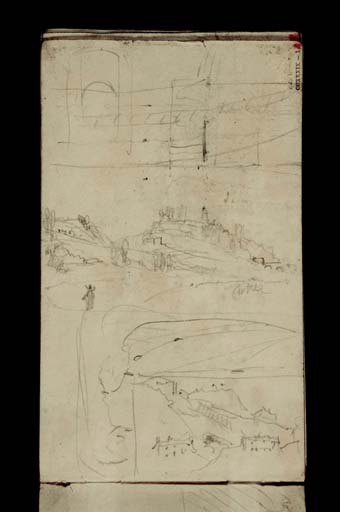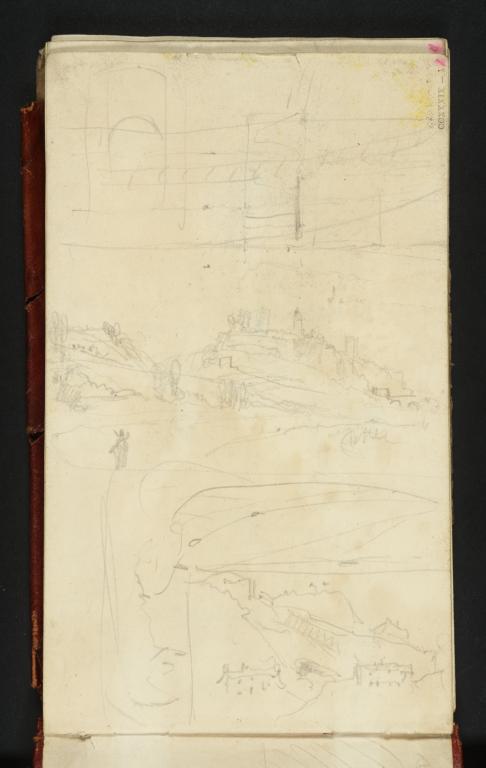Joseph Mallord William Turner ?Scotswood Suspension Bridge, near Newcastle; Bridgnorth from the South; a Sailing Boat; Peveril Castle and Peak Cavern, Castleton ?1831
Image 1 of 2
-
 Joseph Mallord William Turner, ?Scotswood Suspension Bridge, near Newcastle; Bridgnorth from the South; a Sailing Boat; Peveril Castle and Peak Cavern, Castleton ?1831
Joseph Mallord William Turner, ?Scotswood Suspension Bridge, near Newcastle; Bridgnorth from the South; a Sailing Boat; Peveril Castle and Peak Cavern, Castleton ?1831 -
 Joseph Mallord William Turner, ?Scotswood Suspension Bridge, near Newcastle; Bridgnorth from the South; a Sailing Boat; Peveril Castle and Peak Cavern, Castleton ?1831 (Enhanced image)Enhanced image
Joseph Mallord William Turner, ?Scotswood Suspension Bridge, near Newcastle; Bridgnorth from the South; a Sailing Boat; Peveril Castle and Peak Cavern, Castleton ?1831 (Enhanced image)Enhanced image
Joseph Mallord William Turner,
?Scotswood Suspension Bridge, near Newcastle; Bridgnorth from the South; a Sailing Boat; Peveril Castle and Peak Cavern, Castleton
?1831
Joseph Mallord William Turner 1775–1851
Folio 1 Recto:
?Scotswood Suspension Bridge, near Newcastle; Bridgnorth from the South; a Sailing Boat; Peveril Castle and Peak Cavern, Castleton ?1831
D22151
Turner Bequest CCXXXIX 1
Turner Bequest CCXXXIX 1
Pencil on white wove paper, 191 x 114 mm
Inscribed by Turner in ‘[?Cattle]’ centre right
Inscribed by John Ruskin in red ink ‘1’ top right, ascending vertically
Stamped in black ‘CCXXXIX – 1’ top right, ascending vertically
Inscribed by Turner in ‘[?Cattle]’ centre right
Inscribed by John Ruskin in red ink ‘1’ top right, ascending vertically
Stamped in black ‘CCXXXIX – 1’ top right, ascending vertically
Accepted by the nation as part of the Turner Bequest 1856
References
1909
A.J. Finberg, A Complete Inventory of the Drawings of the Turner Bequest, London 1909, vol.II, p.733, CCXXXIX 1, as ‘Hill, with buildings; and other views’.
With the page turned vertically, Turner has made a miscellaneous group of sketches. At the top is a slight drawing, apparently showing a bridge with an arch above it at the far end. It resembles the Scotswood Suspension Bridge or Chain Bridge, about three miles west up the River Tyne from Newcastle, which was supported from a pair of plain, monumental arches. The bridge had only just opened in 1831; it was demolished when the present road bridge was built alongside in 1967.1 For other Newcastle views see under folio 8 recto (D22163).
Across the centre is a distant view of the small town of Bridgnorth, Shropshire, looking north across the fields west of the River Severn. The viewpoint is approximately where the town’s southern by-pass now crosses the river, and the scene is much the same, apart from a few additional houses in the valley and trees on the hill beyond, where the leaning ruins of Bridgnorth Castle, the dome of St Mary Magdalene’s Church and the tower of St Leonard’s are seen from left to right.
Turner had drawn Bridgnorth’s ancient bridge on his 1794 tour through the Midlands in the Matlock sketchbook (Tate D00227, D00228; Turner Bequest XIX 19, 20), leading to a lost watercolour2 which was engraved for the Copper-Plate Magazine in 1795 (Tate impressions: T05886, T05887). By 1831 the bridge had been replaced by a grander structure by the renowned engineer Thomas Telford (1757–1834), who also designed the classical St Mary’s Church, overlooking the Severn; see under D22161. A Turner watercolour of about 1798 has in recent years been called ‘Bridgnorth on the River Severn’ (private collection); it shows a church above the bend of a river, supposedly St Mary’s (although any resemblance appears fortuitous), and is based on a small watercolour River Landscape by his friend Thomas Girtin (1775–1802; Huntington Library, San Marino, California).3
Bridgnorth is midway along the Severn between Worcester and Shrewsbury, also recorded extensively in this sketchbook (see the Introduction). There are similar views of the town on folios 77verso–78 recto (D22292, D22293; Turner Bequest CCXXXIX 76a, 77), 79 recto (D22295; Turner Bequest CCXXXIX 78), and 79 verso–80 recto (D22296, D22297; Turner Bequest CCXXXIX 78a, 79), with others on folios 6 verso–7 recto, 11 verso, 12 recto, 30 verso (D41054, D22161, D22170, D22171, D22205), and 73 verso–74 recto, 74 verso, 75 recto, 75 verso–76 recto, 76 verso, 77 recto, 78 verso, 80 verso–81 recto and 84 recto (D22284–D22291, D22294, D22298, D22299, D22305; Turner Bequest CCXXXIX 72a, 73, 73a, 74, 74a, 75, 75a, 76, 77a, 79a, 80, 83).
Below is a view of a sailing boat, made with the book turned horizontally, with its mast and sail rising to the full height of the page. Rather than being squeezed in among the other drawings, it seems likely that it was made first; there are further sketches of shipping at the other end of the book on folios 92 recto and verso (D22321, D22322; Turner Bequest CCXXXIX 91, 91a) and inside the back cover (D41055). They were perhaps made on the River Thames, as there are also views from Richmond Hill, west of London (see under folio 89 verso; D22316; Turner Bequest CCXXXIX 88a), or near Newcastle upon Tyne (see under folio 8 recto; D22163).
At the bottom right of the vertical page, demarcated by pencil lines between the hull and sail of the boat, is another small landscape sketch, showing Peveril Castle and Peak Cavern to the south above Castleton. For other views of these, see under the verso (D22152).
See ‘Fact Files: The Scotswood Bridges’, Tyne & Wear Archives & Museums, accessed 22 November 2013, http://www.twmuseums.org.uk/discovery/buildingbridges/the-scotswood-bridges/ , giving the grand opening as 16 September, just a few days before Turner would have passed through Newcastle (see the sketchbook’s introduction), although other sources give the date as 16 April, including E. Mackenzie and M. Ross, An Historical, Topographical, and Descriptive View of the County Palatine of Durham, Newcastle 1834, vol.I, p.201.
Technical notes:
There appear to be traces of yellow pigment at the top right, offset to or from the corresponding corner inside the front cover (D41053). These may be fortuitous, and possibly related to the decorative yellow wash applied around the outer edges of the page block. Otherwise watercolour is restricted in this book to the rough localised washes over pencil on folio 91 recto (D22319; Turner Bequest CCXXXIX 90).
Matthew Imms
April 2014
How to cite
Matthew Imms, ‘?Scotswood Suspension Bridge, near Newcastle; Bridgnorth from the South; a Sailing Boat; Peveril Castle and Peak Cavern, Castleton ?1831 by Joseph Mallord William Turner’, catalogue entry, April 2014, in David Blayney Brown (ed.), J.M.W. Turner: Sketchbooks, Drawings and Watercolours, Tate Research Publication, September 2014, https://www

